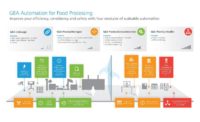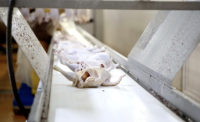Bringing transparency to meat and poultry processing through the ability to track and trace products from the farm through the supply chain to the table is a complex challenge. It is, however, one worth addressing as consumers and retailers start to expect and demand it.
Government agencies are taking note of the potential for traceability to improve food safety as well. Following an in-depth investigation into a 2017 Salmonella outbreak involving ground beef, the U.S. Centers for Disease Control (CDC) noted that traceability would make identifying the source of an outbreak much easier:
“Foodborne outbreak investigations could be enhanced by improvements in the traceability of cows from their originating farms or sale barns, through slaughter and processing establishments, to ground beef sold to consumers.”
Of course, achieving that level of transparency will take time and involve the adoption of new technologies across the supply chain. That includes opportunities with blockchain, RFID chips implanted in animals, and Internet of Things (IoT) solutions used to monitor food safety requirements in a connected supply chain.
What these innovations have in common is the fact that they produce data, which provides valuable insights, and that’s where IT strategy plays a crucial role in food safety.
Supply chain data visibility and food safety
One of the first steps meat and poultry processors should take to improve track and traceability is mapping out where data lives in relation to all the moving parts. What applications does the data flow through? What execution venues and platforms do those applications live on? What partners need access to the data and how will that be managed?
Some organizations take the approach of identifying tools to help combine and visualize data to inform business decisions. However, for compliance-driven organizations, such as food manufacturers, it may be more beneficial to work on data management, governance and integration. Data visibility is less about what tools are used and focuses instead on understanding and trusting the source of the data, including how it was combined and transformed along the supply chain to meet regulations and show compliance.
Adopting a multi-cloud strategy
The ability to integrate applications and share data with suppliers, distributors, retailers and other supply chain partners is vital to the success of any IT modernization effort. Increasingly, that connectivity is accomplished through the implementation of cloud solutions. Because different partners use various cloud platforms, food manufacturers must be able to operate in multi-cloud environments.
The best place to start is with a scalable digital platform that supports future initiatives, including those that will improve track and traceability of your products. As you move away from legacy systems and modernize your applications, it may be necessary to implement a hybrid IT strategy, allowing you to transition toward an ERP solution, for example, hosted in the cloud or even allow the components of your applications to be hosted across multiple clouds.
The bottom line is that processors who begin modernizing IT operations technology now will be well-positioned to implement digital solutions for track and traceability in the future. NP




Report Abusive Comment